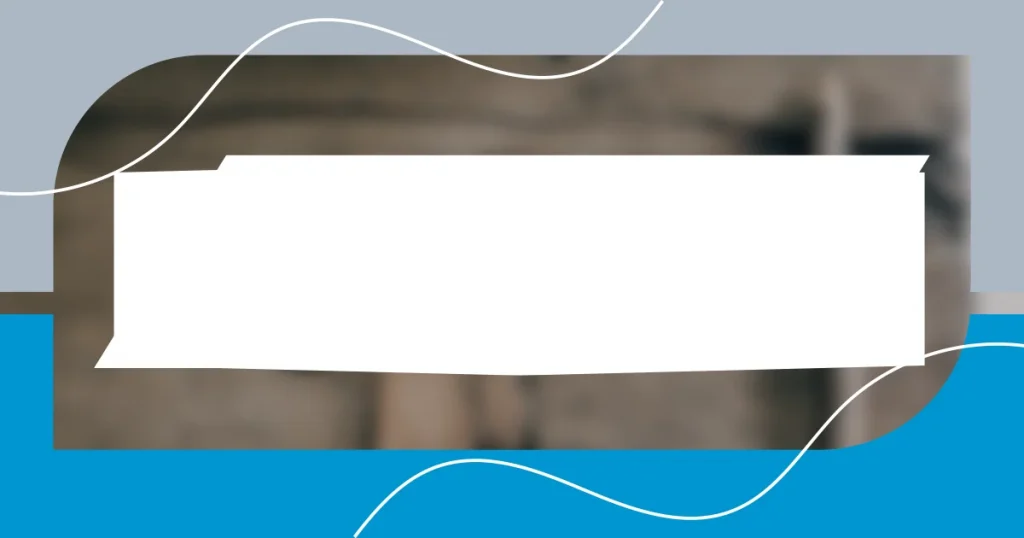Key takeaways:
- Understanding finish durability is crucial for protecting furniture and prolonging its lifespan; the type of material and finish significantly impacts durability.
- Testing methods like the nail scratch and water spot tests help assess finish resilience and moisture resistance, ensuring long-term performance.
- Regular maintenance, using proper cleaning products, and preventing exposure to harmful conditions (like UV rays) are essential for preserving the integrity of finishes.

Understanding finish durability matters
When I think about finish durability, I can’t help but recall a piece of furniture I bought years ago. I chose a beautiful oak table, but neglected to consider the finish. After a few months of everyday use, those deep scratches started to show, and I remember feeling a pang of regret. Why hadn’t I prioritized durability from the start?
Understanding the importance of finish durability can truly transform how you approach your projects. Have you ever experienced the frustration of a finish wearing away too quickly? I have, and it’s incredibly disheartening to see something you love lose its luster. A durable finish not only enhances the aesthetics of a piece but also protects it against wear, tear, and environmental damage.
Every time I apply a new finish, I remind myself that it’s more than just about looking good—it’s about safeguarding my investment. It often requires a deeper dive into the materials used. For instance, knowing the differences between oil-based and water-based finishes can make all the difference. Are you aware of which one lasts longer in your specific environment? Taking the time to understand these factors gives you peace of mind and significantly prolongs the life of whatever you’re working on.

Factors affecting finish durability
When considering finish durability, the type of material you’re working with plays a crucial role. I once refinished a vintage dresser made of soft pine. Despite my care in selecting a finish, the soft wood quickly showed dings and scratches, which taught me the hard way that not all surfaces are created equal. This experience made me appreciate the relationship between material hardness and finish longevity more than ever.
Here are key factors that influence finish durability:
- Material Type: Hardwoods like oak and maple generally provide better resistance to wear than softwoods like pine and cedar.
- Finish Type: Oil-based finishes tend to offer better protection compared to water-based ones, but they take longer to dry.
- Environmental Conditions: Factors like humidity and temperature can affect how a finish cures and maintains its integrity over time.
- Application Method: Proper application techniques, such as sanding and layering, can enhance the adhesion and resilience of the finish.
- Maintenance: Regular care, like cleaning and reapplication, can significantly extend the life of any finish.
Reflecting on these aspects not only helps in making informed choices but also saves you from the heartache of an unprotected piece. Each project becomes a lesson learned, and I find that every scratch or blemish tells its own story of how I can do better next time.

Testing finish durability effectively
When it comes to testing finish durability effectively, I often think about the nail scratch test. A couple of years ago, I was finishing a handcrafted coffee table, and out of sheer curiosity, I decided to see how resilient the finish was. Taking a fingernail, I lightly scratched its surface and was relieved to find it barely marked. This simple test gave me confidence in my work and highlighted the importance of such practical evaluations.
Moreover, I like to perform a water spot test on new finishes. I remember applying a water-based finish for the first time and placing a few drops of water on it. After a few hours, I wiped off the water, and to my delight, there were no rings left behind. This not only proved the finish’s durability but also its effectiveness against moisture—essential for any table that might host a coffee mug. Tests like these help verify the long-term performance before putting a piece into daily use.
| Test Type | Description |
|---|---|
| Nail Scratch Test | Lightly scratch the surface to assess durability against dents and gouges. |
| Water Spot Test | Place water drops to check for staining and moisture resistance. |
It’s also vital to consider temperature changes in your testing methods. I recall working in a garage that fluctuated between hot and cold months. I decided to set aside a piece with a newly applied finish in this environment and observed how it fared over time. The finish held up beautifully, which was a relief. Testing under such varied conditions gave me valuable insight into how those extremes could impact durability. This way, you prepare yourself against potential pitfalls and ensure you choose the right finish for your project. Each time I undertake these tests, I feel more equipped to tackle future projects with confidence.

Maintaining and preserving finishes
Maintaining the brilliance of a finish really comes down to regular upkeep and a bit of love. I remember walking into a friend’s home and immediately noticing a beautiful dining table that had lost some of its luster. She mentioned that it had only been cleaned with water and a cloth for years. This experience reminded me how crucial it is to use appropriate cleaning products specifically designed for finishes, which can help protect and restore the surface.
Reapplication of a finish can sometimes feel like an overwhelming task, but I’ve found it profoundly satisfying. Not too long ago, I took on the job of renewing a varnish on my family’s old sideboard. After carefully sanding and cleaning, I applied a fresh coat, and the transformation was breathtaking. It’s these moments that reinforce the idea that maintenance doesn’t just prolong the life of a finish; it revitalizes the piece and keeps it a cherished part of your environment.
Let’s not forget the importance of creating a protective barrier for your finishes. Have you ever thought about how sunlight can slowly erode a beautiful stain? I once had a stunning wooden chair that I had placed near a window, and over time, the color began to fade. Now, I always use UV-protective films or draw the curtains during peak sunlight hours to shield my furniture. It’s such a small step, but it makes a world of difference in preserving finishes.

Common issues with finish durability
When discussing common issues with finish durability, one major frustration that comes to mind is chipping. I remember finishing a beautiful wooden chair that I was particularly proud of, only to find a small chip after a single use. This incident made me realize how easily a finish can be compromised, especially in high-traffic areas. I often wonder how many people overlook this risk in their woodworking projects.
Another concern that frequently arises is the impact of humidity. During a particularly humid summer, I noticed warping on a table I had finished with a water-based varnish. It was disheartening to see my work affected by something I couldn’t control. This experience taught me to anticipate environmental factors when selecting finishes and to consider using products specifically designed for moisture resistance.
Then there’s the question of fading. I vividly recall a time when I arranged my living room around a stunning wooden cabinet—only to watch, in disbelief, as sunlight began bleaching its rich tones. It was a stark reminder of how UV rays can wreak havoc on finishes over time. This motivates me to use protective coatings and arrange furniture wisely to avoid direct sunlight. Ultimately, these common issues serve as critical lessons in choosing and maintaining finishes that truly stand the test of time.

Tips for extending finish longevity
It’s amazing how a little precaution can dramatically extend the life of a finish. I once had a friend who’d cook frequently in his kitchen but overlooked the importance of using trivets under hot pots. One day, I noticed a dull patch where a hot pan had scorched the finish. It made me think about how easily we can protect our finishes with simple habits, like using coasters and mats to mitigate heat and moisture damage. Have you ever considered how everyday activities could unknowingly jeopardize your cherished pieces?
A good tip I picked up along the way is to avoid harsh chemicals in cleaning solutions. I remember using a strong cleaner on a beautiful lacquered surface and watching it strip away the sheen. It was a tough lesson learned! Nowadays, I opt for pH-neutral cleaners or even a concoction of vinegar and water. It’s gentle yet effective and helps maintain that lovely glow. Isn’t it surprisingly rewarding to see your lovingly maintained furniture retain its character?
Another habit that I’ve embraced is seasonal inspections. Just recently, I took the time to examine my outdoor furniture for any wear and tear following a harsh winter. I was surprised by how a proactive approach of cleaning and touching up the finishes prevented bigger issues from surfacing. If you haven’t done this before, why not make a little checklist? Taking a few moments to inspect and reapply finishes can save a lot of heartache later on!














